One of the most fun projects that I’ve had the chance to bring to life is a reproduction of a late 1830s dress held at the Victoria & Albert Museum.
Having sewn 1830s garments before, the bodice and skirt seemed rather easy to me. But the sleeves were where the fun began.
Besides the museum site, you can view this dress in Nineteenth Century Fashion in Detail (a favorite drool book of costumers).
Let’s break down the sleeve then see how I translated that into reality with a few lessons learned as well.
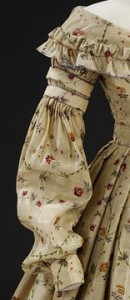
Look close. Because of the particular weave of the fabric you can see the lower bishop part of the sleeve is cut on the straight of grain. It is set into a wide cuff that is piped all around.
Then there is a set of bands that are both piped. The upper portion of the sleeve is narrow pleated to fit the armhole. (We can’t see much here as the fabulous collar is hiding those secrets.)
I had read that as the sleeves were collapsing in style as the 1830s progressed, the full upper portion was simply smoothed down to fit a snug armband or lining through either pleats or multiple rows of fine gathers. You can see that here, so I decided to pursue this method.
After much research on sleeve pattern shapes I decided on one from Jean Hunnisett and drafted out an Early Victorian multi-puffed sleeve. It was a straight sleeve with lines for gathering sections bound by bands down the arm. I then greatly reduced the sleeve head and width to make it less like the classic Romantic Era leg o’ mutton sleeve.
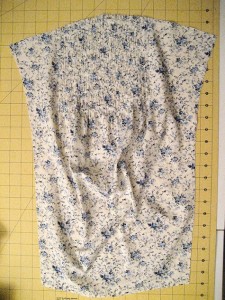
Then came the hard part – pleating that entire sleeve cap into a shape that fit into the bodice armhole and fit my upper arm snuggly. Oh, and it needed to look good.
Well, I can tell you now that it was a PITA project.
Ok, so the original looked like it was simply pleated into about ¼” pleats. Nothing perfect or even uniform across the whole thing. So that’s what I did…. Yep…. 2 frickin’ hours later I had ONE sleeve pin pleated to within an inch of its life (and a sore lower back from standing hunched over my ironing board for so long).
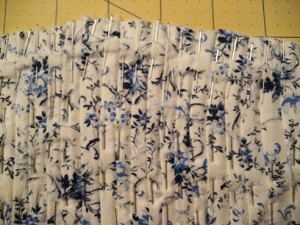

I basted across the cap edge and at the two lines where I was going to sew the bands on to hold all the pleats down. Yeah… so not perfect. I didn’t like it but I wasn’t about to start over on another pattern.
So onto the easy parts: making the cuff and bias bands.
The bands holding the pleats were made from my arm measurements. They were cut as bias strips, topped with a mini piping edge then topstitched to the sleeve. I also made them narrower than the original because I wanted to show off more of the tiny pleats of the sleeve. I think my interpretation was short changed with this decision – a wider size would have looked better.
The cuffs were cut as 2-1/4″ finished width and piped all around to keep with what I had read in Costume in Detail as well as what you can see on the original.
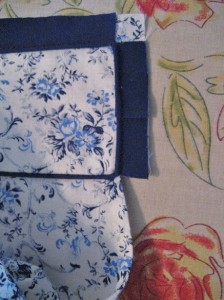
The biggest lesson I learned from making up this sleeve was how the sleeve is actually cut. The fabric grain is so easy to see on the original – well at least in the lower bishop part. So I made the decision that the entire sleeve was cut as one piece on the straight of grain.
But it’s so hard to tell from the few photos of the original gown if that upper pleated portion is cut on the bias or on grain.
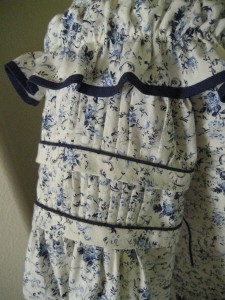
If I were to make this sleeve again (or for a future late-1830s dress), I would cut the lower bishop on grain then have a seam at the first band. The upper portion of the sleeve head would be cut on the bias so the pleating would be easier to manipulate.
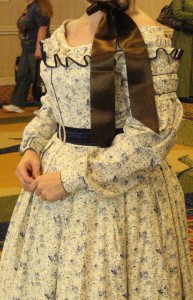
Overall I love this dress and I enthusiastically love the 1830s no matter how the sleeves turned out.
I would definitely do it again. Hmm… perhaps in red. ??

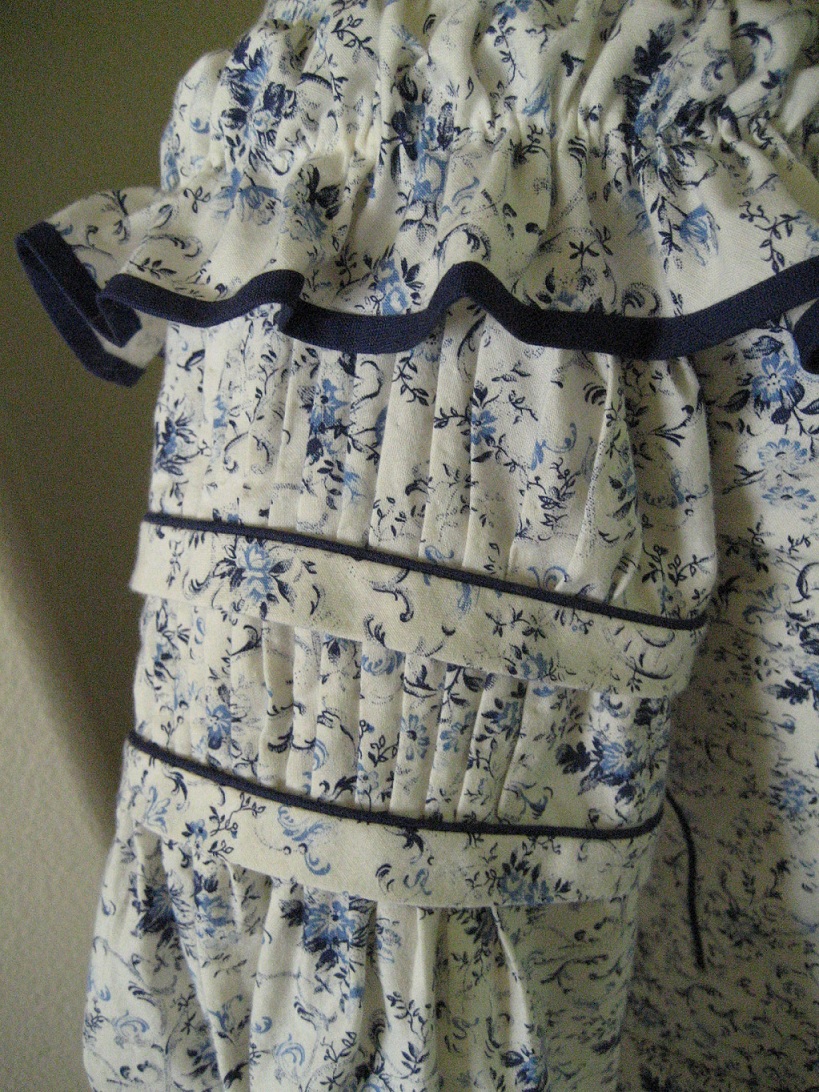

Have you made yourself a pleater board? Pleating goes much faster.
No. But this sleeve wouldn’t have worked in one as the pleats are not even and are worked around non-bias cut fabric.
Maybe the seamstress smocked under the bands and gathered only on the top. The area in the original does not look flattened down. You would have to sew the bands only to the top ridges of the smocking. The only way to tell is to write to the clothing curate at the museum. They might answer back.
I love the fabric you used for your dress. It’s so pretty! 🙂
The late 1830’s bug has bitten me! I have been daydreaming about making one (along with all the underpinnings). What kind of fabric do you suggest using (linen, cotton, silk)? I would like to use the Period Impressions 1837 Day Dress as my pattern
Uh, yes. 🙂 But cottons are perfect for day dresses. Check my Romantic Era Pinterest board for a look at fabric colors and prints. I <3 the 1830s!
Beautiful! I recently produced a Regency-Era play, and was dismayed to find that there are very few 1830s-1840s dresses available among theatrical costume shops–people kept saying, “there just aren’t that many plays set in that era.”
Very good job! The sleeves turned out beautifully. My tip when using the ironing board for a work top is to lower it & pull up a chair. That’s what I did when I was doing a million yards of pleating. It made a huge difference.
Huh!!! That is super neat! I have always wondered how I would do that type of sleeve when I attempt my first early 40s dress!! Thank you for your tutorial!!!
Do you have a blog page on your Green 1830s dress? I love this era too. It doesn’t get it’s fair share of attention. I like your dress here. Nice sleeves!
Yes! You can read about my Slytherin Dress here: https://historicalsewing.com/1830-acid-green-slytherin-dress
I loved your sleeves, and wanted to do something like that. I’ll have to save this link for when I get back to 1830s.